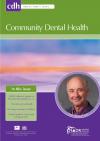Community Dental Health

- Cover Date:
- June 2016
- Print ISSN:
- 0265 539X
- Vol:
- 33
- Issue:
- 2
Feasibility, utility and impact of a national dental epidemiological survey of three-year-old children in England 2013
Dental epidemiological surveys of children often focus on caries levels of ï¬ve-year-olds as they are accessible and amenable to examination. Standardised surveys of this age group have been successfully carried out in the UK for many years. If improvements to caries level at age ï¬ve are to be made then it is important to know when caries develops in the preceding years and what the likely causes are. This paper reports on the feasibility, utility and impact of a standardised survey of three-year-old children which took place in England. Method: Standardised examinations were carried out on consented three-year-olds attending child care sites which had been randomly sampled using a method described in a national protocol. Feasibility was assessed by compliance results, utility from examples of use of
the data and impact by a count of media responses at the time of publication. Results: Data from 53,814 examinations provided caries level estimates for 88% of lower tier local authorities, this number representing 8% of the population of this age cohort. Of the children for whom parental consent was provided, 8% refused to be examined at school and 9% were absent. The arising information was used in a variety of ways by local authorities and health planners. The media response was strong with coverage by TV, radio, printed press and online reporting. Conclusion: This national survey of the oral health of three year olds was feasible but more labour intensive than surveys of school age children and the information derived has good utility and impact.
Key words: child, dental epidemiology, caries, three-year-olds, preschool, England, UK
doi:10.1922/CDH_3918Davies05
- Article Price
- £15.00
- Institution Article Price
- £
- Page Start
- 116
- Page End
- 120
- Authors
- J. Neville, D. Wilcox
Articles from this issue
- Title
- Pg. Start
- Pg. End
- Child oral health in migrant families: A cross-sectional study of caries in 1-4 year old children from migrant backgrounds residing in Melbourne, Australia
- 100
- 106
- Feasibility, utility and impact of a national dental epidemiological survey of three-year-old children in England 2013
- 116
- 120
- A bi-level intervention to improve oral hygiene of older and disabled adults in low-income housing: results of a pilot study
- 127
- 132
- Caries and costs: an evaluation of a school-based fluoride varnish programme for adolescents in a Swedish region
- 138
- 144
- Examiner reliability in fluorosis scoring: a comparison of photographic and clinical methods
- 145
- 150
- Do ‘poor areas’ get the services they deserve? The role of dental services in structural inequalities in oral health
- 164
- 167
